Hydrogen Peroxide
Pure hydrogen peroxide (H2O2) is a pale blue liquid, mixable in any ratio with water. Low-percentage aqueous solutions are widely used as bleaching agents due to their strong oxidizing properties. Besides for the bleaching of wood, paper or hair, hydrogen peroxide solutions are also used as oxidizing agents or in medical application as disinfectants. The tendency of hydrogen peroxide to decompose into water and oxygen (see equation 1 below) is the reason for its application as a liquid propellant in rocket engines.
(equation 1)

Multiple Module Calorimeter (MMC)
The NETZSCH Multiple Module Calorimeter Calorímetro de Múltiplo Módulo (MMC)A multiple mode calorimeter device consisting of a base unit and exchangeable modules. One module is prepared for accelerating rate calorimetry (ARC), the ARC-Module. A second one is used for scanning tests (Scanning Module) and a third one is related to battery testing for coin cells (Coin Cell Module).MMC 274 Nexus® (figure 1) offers three different measurement modules [1]. The Calorimetria por taxa de Aceleração (ARC)The method describing isothermal and adiabatic test procedures used to detect thermally exothermic decomposition reactions.ARC® Module can be used for thermal hazard studies; the Coin-Cell Module is specialized for the investigation of batteries; and the Scanning ModuleA calorimeter module being part of the Multipe Module Calorimeter (MMC) allowing for scanning test of a sample. This procedure can serve as a screening test in order to detect a thermal hazard potential within a reasonably short measurement time.Scanning Module can be used to evaluate caloric data from a single heating run. In contrast to the widely used and well-known technique of differential scanning calorimetry (DSC), the Scanning ModuleA calorimeter module being part of the Multipe Module Calorimeter (MMC) allowing for scanning test of a sample. This procedure can serve as a screening test in order to detect a thermal hazard potential within a reasonably short measurement time.Scanning Module of the MMC can handle samples up to a volume of 2 ml. For heating the samples, there are two options available: either a constant heating rate or a constant level of power. By using information about both the power supplied to the sample and the heating rate, a heat-flow signal can be calculated. Using metals such as indium, tin and bismuth, both the temperature and the sensitivity of the instrument can be determined. At 1000 to 9000 mg (sample volume about 1 ml), typical sample masses are considerably higher for the MMC than sample masses used for DSC, which are typically between 5 and 10 mg. Even so, the evaluated uncertainty for the Scanning ModuleA calorimeter module being part of the Multipe Module Calorimeter (MMC) allowing for scanning test of a sample. This procedure can serve as a screening test in order to detect a thermal hazard potential within a reasonably short measurement time.Scanning Module of the MMC is about 1% for temperature determinations and less than 5% for enthalpy determinations.
This work studies the thermal Reação de DecomposiçãoA decomposition reaction is a thermally induced reaction of a chemical compound forming solid and/or gaseous products. decomposition behavior of hydrogen peroxide (35%) employing two MMC modules, the Scanning ModuleA calorimeter module being part of the Multipe Module Calorimeter (MMC) allowing for scanning test of a sample. This procedure can serve as a screening test in order to detect a thermal hazard potential within a reasonably short measurement time.Scanning Module (see figure 2) and the ARC® Module (see figure 3). Via an external heater which directly surrounds the sample vessel (figure 4), the Scanning ModuleA calorimeter module being part of the Multipe Module Calorimeter (MMC) allowing for scanning test of a sample. This procedure can serve as a screening test in order to detect a thermal hazard potential within a reasonably short measurement time.Scanning Module can provide the sample with a constant level of power.
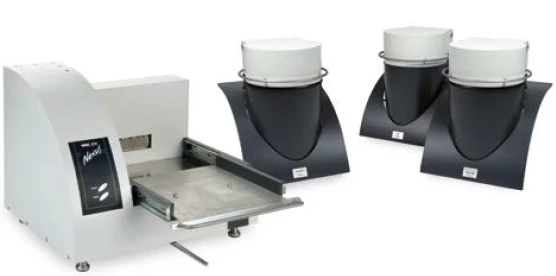
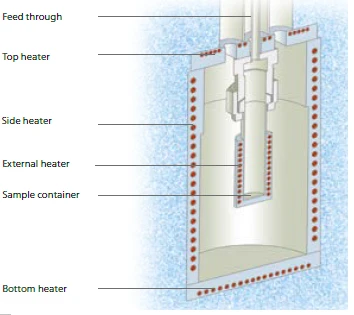
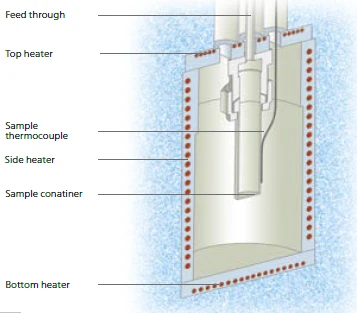
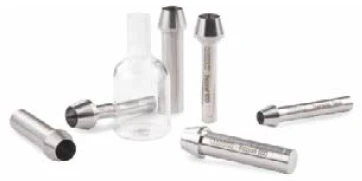
Measurement Conditions
The measurement conditions are summarized in table 1. Hydrogen peroxide (Sigma Aldrich) was received as an aqueous solution (35%) and is stored at ambient temperature.
Table 1: Measurement conditions
MMC 274 Nexus® | ||
|---|---|---|
| MMC Module | Scanning | ARC® |
| Vessel material | Stainless steel | Stainless steel |
| Vessel type | Closed | Closed |
| Vessel mass | 7176.38 mg | 7233.59 mg |
| Heating | Constant power (250 mW) | Calor – Esperar – PesquisaHeat-Wait-Search is a measurement mode used in calorimeter devices according to accelerating rate calorimetry (ARC).HWS |
| Atmosphere | Air | Air |
| Purges gas rate | Static | Static |
| Temperature range | RT...250°C | RT...250°C |
| Sample mass | 1031.1 mg | 1008.1 mg |
Comparison of the Behavior of H2O2, H2O and Empty Vessel
The results in figure 5 present exclusively the sample heating. Since the decomposition reaction of hydrogen peroxide is not reversible, the oxygen generated is not taken up again in order to form the initial hydrogen peroxide during cooling. Instead, the formed products of water and oxygen cool to ambient temperature as a liquid and a gas, respectively. The pressure signal indicates 17.7 bar at 40°C, which reflects the amount of oxygen being formed during decomposition (figure 6). Taking the same amount of water instead, the pressure also increases during heating, but since water remains chemically unchanged, all water vapor precipitates again during cooling. That’s why the dashed blue line, indicating the pressure signal for water during cooling, shows values almost identical to the heating (solid lines). Just for comparison, the green lines show the course of the pressure signal during heating and cooling for an empty vessel.
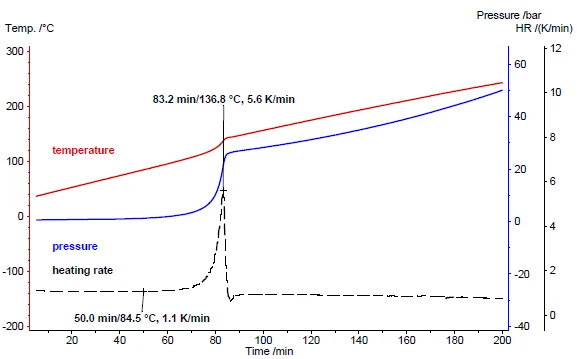
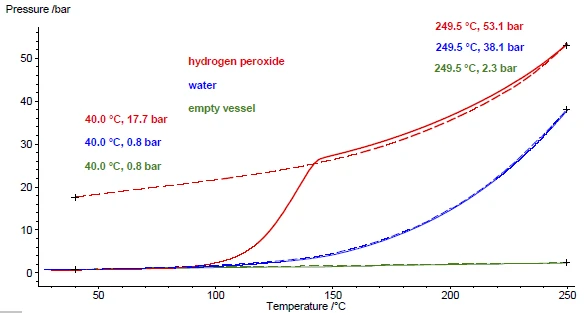
Advantages of the Scanning Module
These results obtained by the MMC Scanning Module clearly demonstrate that the discontinuous course of the heating rate along with the pressure build-up are excellent indicators for hazard potential in terms of Reação de DecomposiçãoA decomposition reaction is a thermally induced reaction of a chemical compound forming solid and/or gaseous products. decomposition reactions or exothermic reactions. Even a small power level such as 250 mW, resulting in a comparably small heating rate of approximately 1 K/min, the heating for this exemplary measurement takes less than 4 hours. Therefore, the MMC Scanning Module is well suited to be used as a screening tool. In cases where pressure and/ or temperature increase are detected, an AdiabáticoAdiabatic describes a system or measurement mode without any heat exchange with the surroundings. This mode can be realized using a calorimeter device according to the method of accelerating rate calorimetry (ARC). The main purpose of such a device is to study scenarios and thermal runaway reactions. A short description of the adiabatic mode is “no heat in – no heat out”.adiabatic test should be the next step.
Accelerating Rate Calorimetry
Specialized calorimeters allow for sample investigation in accordance with the method of accelerated rate calorimetry (ARC®). An ARC®-type equipment offers an adiabatic sample environment in order to not allow any heat exchange and to detect even the smallest of self-heating reactions. The typical measurement mode is called heatwait-search (HWS). The sequence of heating, equilibration and detection of even the smallest of self-induced temperature changes is a quasi-isothermal approach used in order to determine the temperature at which the decomposition reaction starts. A diagram depicting heat-wait-search is shown in figure 7.
A cross-section of the MMC’s ARC® Module set-up is depicted in figure 3. If the Self-heating rateA special kind of calorimeter device is used in order to detect the self-heating rate of a substance. The related method is called accelerating rate calorimetry (ARC). self-heating rate of 0.02 K/min is exceeded during the detection period (search), the measurement changes from heat-wait-search to adiabatic mode. This means the surrounding heaters (top, side and bottom) no longer follow the above-mentioned sequence, but rather track the sample temperature. During this “adiabatic” mode, there is no temperature difference and thus no heat exchange between the sample and the calorimeter environment.
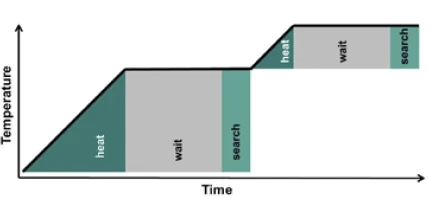
H2O2 in the ARC® Module
Figure 8 depicts the results of the decomposition of hydrogen peroxide (35%) investigated with the MMC’s ARC® Module employing the heat-wait-search mode. The temperature increment in the stepwise heating was 10 K and the system was allowed to stabilize for 30 minutes during the wait segment. The answer to the question of whether or not an exothermic event is detected during the 10-minute search period depends on the Limiar ExotérmicoThe exothermic threshold is a value for the self-heating rate of a sample (typically 0,02 K/min) which determines whether or not an exothermic event is detected within an experiment using a calorimeter device according to accelerated rate calorimetry (ARC). exothermic threshold. Between 40°C and 70°C, self-heating during the search period was less than 0.02 K/min and the heatwait-search sequence continued. At 80°C, the detected self-heating had exceeded that threshold and the calorimeter thus changed over to the adiabatic mode. The temperature increase (ΔTobs) was detected to be 41.5 K. Taking Thermal inertiaThe thermal inertia is equivalent to the PHI-factor. Both describe the ratio of mass and specific heat capacity of a sample or sample mixture compared to that of the vessel or sample container.thermal inertia [1] into account, the adiabatic temperature increase is calculated to be 94.9 K (ΔTad). The difference is based on the so-called PHI-factorThe PHI-factor (Φ) is equivalent to the thermal inertia. Both describe the ratio of mass and specific heat capacity of a sample or sample mixture compared to that of the vessel or sample container. PHI-factor which is mainly given by the ratio of mass times Specific Heat Capacity (cp)Heat capacity is a material-specific physical quantity, determined by the amount of heat supplied to specimen, divided by the resulting temperature increase. The specific heat capacity is related to a unit mass of the specimen.specific heat capacity of the container versus mass times Specific Heat Capacity (cp)Heat capacity is a material-specific physical quantity, determined by the amount of heat supplied to specimen, divided by the resulting temperature increase. The specific heat capacity is related to a unit mass of the specimen.specific heat capacity of the sample. In addition to the increase in temperature caused by self-heating of the sample during decomposition, the pressure increase can also be quantified. At the end of the adiabatic segment, the increase in pressure was more than 20 bar.

Conclusion
The decomposition behavior of a 35% aqueous hydrogen peroxide solution was investigated with the MMC’s Scanning Module as well as with its ARC® Module. Since the Scanning Module is operated using either a constant level of power (as was the case here) or a constant heating rate, these experiments are far less time-consuming than with the heat-wait-search method. Therefore, the Scanning Module is an excellent screening tool for investigating unknown samples with respect to self-decomposition or hazardous potential. In cases where an investigated sample exhibits unsteady temperature behavior during the scanning run, or in cases where a decomposition reaction is indicated by pressure build-up, any further investigation on the samples should be carried out using ARC®-type equipment. Values such as pressure build-up as well as observed and adiabatic temperature rise are extremely important in assessing the hazardous potential of chemicals and can easily be obtained using the NETZSCH Multiple Module Calorimeter MMC 274 Nexus®.